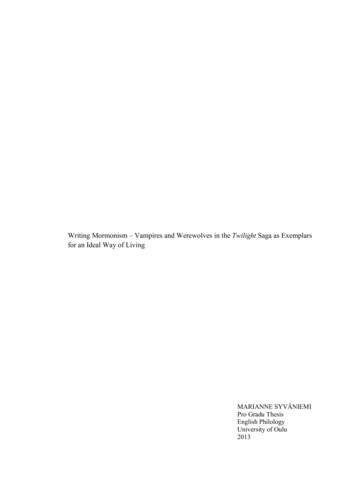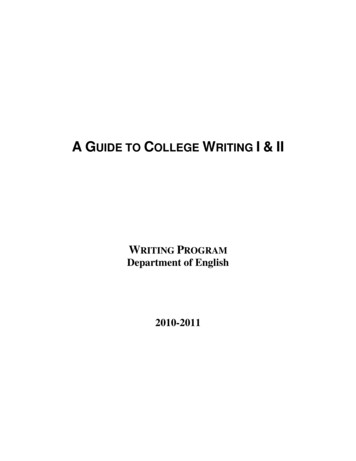
Transcription
Writing Mormonism – Vampires and Werewolves in the Twilight Saga as Exemplarsfor an Ideal Way of LivingMARIANNE SYVÄNIEMIPro Gradu ThesisEnglish PhilologyUniversity of Oulu2013
2Table of Contents1. Introduction . 32. The Twilight Saga . 52.1. Plot Summary and Introducing Central Characters . 52.2. Special Abilities of the Vampires . 92.3. About the Author Stephenie Meyer . 103. Theoretical Background of Monsters and Mormonism . 133.1. Vampires and Werewolves . 133.2. The Church of the Latter-day Saints . 164. Society . 204.1. Networks . 204.2. Authorities . 214.3. Capitalism and Education . 295. The Nuclear Family. 336. Converting and Transforming . 436.1. Mormon Conversion. 436.2. Changing Vampires . 456.3. Becoming a Werewolf . 497. Conclusion . 52References . 55
31. IntroductionThis study focuses on the series of four vampire books written by Stephenie Meyer,which are commonly known as the Twilight saga. The general aim of this study is toshow how Meyer’s religious background and views are portrayed in the novels,either directly or incidentally.Teenagers quite often get interested in the same book or film which then becomepopular all over the world. In the past such films or books have been for exampleThe Lord of the Rings -saga and the Harry Potter fantasy novels. The most wellknown characters at the moment, however, are Bella and Edward – the central couplein the Twilight saga. It is not only the four books written by Stephenie Meyer but alsothe Hollywood film adaptations that draw the attention of teenagers as well as adults.The reason why I first started reading the Twilight books is that I work withteenagers, and I think it is important to get familiar with current popular literature.The subject of the Church of Jesus Christ of Latter-day Saints (the Mormons)became interesting when looking at the writer of the saga, Stephenie Meyer, and afterreading some of her statements. It awoke questions: How did she create the vampireimage and why is it so different from the old terrifying image of a bloodsucker? Didher religion influence her writing and if so, in which ways can it be seen in thenovels? The aim of this study is to find out answers to these questions by comparingthe images and ideals presented in Twilight to the norms of the Church of JesusChrist of Latter-day Saints (the LDS Church).Even though the LDS Church shares holy books with other Christian religions, it isstill very different. The dissimilarity of the Mormon faith in comparison to thesurrounding world is described in the following quotation by Gilmore:My mother was born into a world of early twentieth-century MormonUtah— a place that, in many respects, was dramatically different fromthe America that surrounded it. The Mormons had long possessed astrong and spectacular sense of otherness and unity: They sawthemselves not only as God’s modern chosen people, but also as a peoplewhose faith and identity had been forged by a long and bloody history,
4and by outright banishment. They were a people apart— a people with itsown myths and purposes, and with a history of astonishing violence.(Gilmore, 2003: 259)This difference to the American society will be of importance when discussing howMeyer’s faith is present in her novels.In my thesis I first give a theoretical background to the Church of Jesus Christ ofLatter-day Saints and then outline the traditional and contemporary presentations ofvampires and werewolves. These will be used to support my general argument thatthrough her writing Meyer conveys her own religious beliefs through her novels. Theanalysis will be based on this theoretical foundation.
52. The Twilight SagaThe roots of the Twilight series lie in a dream the author Stephenie Meyer had: shesaw a beautiful vampire and an average looking girl in a meadow. Meyer could notforget the discussion between this uneven couple and it lead to the series which nowconsists of four novels: Twilight, New Moon, Eclipse and Breaking Dawn. The firstbook, Twilight, was published in 2005, New Moon in 2006, Eclipse in 2007 andBreaking Dawn in 2008. There are also two spinoff books, which I do not discuss inmy thesis: The Short Second Life of Bree Tanner (the story of a new-born vampirewho appears in Eclipse) and Midnight Sun (presenting the events of Twilight fromEdward’s view).This modern vampire story – spiced with romance – rapidly became very popularamong teenagers all over the world, and even adults are fascinated by the love storybetween the gentleman vampire and the girl next door. After the first film, Twilight,was released in 2008, an even wider public was attracted. In 2009 the sequel TheTwilight Saga: New Moon followed, and the next year The Twilight Saga: Eclipsecame to the movie theatres. The last book’s film version – Breaking Dawn – consistsof two separate parts, which were released in autumn of 2011 and 2012. The bookshave sold over 100 million copies so far and have been translated into more than 30languages.2.1. Plot Summary and Introducing Central CharactersThe first book, Twilight, tells how Bella falls in love with Edward, and how she findsout about the true personality of the Cullens and learns about vampires. It alsodepicts the threat vampires present as she is chased by a vampire. The novel beginswith Bella Swan’s move from the sunny city of Phoenix to a small town, Forks, tolive with her father. Bella’s mother Renée has re-married and Bella does not want tohold her mother back from travelling with her new husband. In Phoenix Bella wasnot popular, because she is not brown or athletic like the others. In Forks, however,
6the new girl is almost an attraction and everyone wants to get to know her – exceptthe Cullens. The Cullen family consists of the parents Carlisle and Esme and theiradopted children Edward, Alice, Jasper, Rosalie and Emmet. Carlisle is a respecteddoctor and all the family members are beautiful. As is revealed later, they are all infact vampires, most of them (Edward, Esme, Rosalie and Emmett) created byCarlisle. At school the Cullens keep to themselves, and they are admired for theirlooks and their money. The Cullen coven (coven is similar to a family) does not feedon human blood, and they have lived in the same area for several years – bothuncommon characteristics for vampires in the Twilight world. Other centralcharacters are Bella’s father Charlie, Forks’ Chief of Police, and Jakob Black, amember of the Quileute tribe (later a shape shifter and the leader of the werewolfpack).The most important coven in the vampire society is the Volturi, the oldest and largestcoven which is located in Italy. The three leaders of this coven have created rules andregulations to keep the existence of vampires secret. Among these are the laws thathumans should not be told about vampires and that, child vampires should not becreated. If a vampire violates these regulations, the Volturi punishes him or her,sometimes even the whole coven. The members of the Denali coven, on the otherhand, live like the Cullens on animal blood and they have a permanent home as well.The more traditional way of living for the vampires in the Twilight saga is to live asnomads and obviously feed on human blood.The second book of the saga, called New Moon, begins with Bella’s birthday party.Bella has turned a year older than Edward’s physical age, and Bella desperatelywants to become a part of the Cullen family – a vampire like them. During the partyBella gets a small cut, and the drop of blood triggers the feeding instinct of Jasperwho tries to bite Bella. However, Edward manages to protect her, and the situation issoon over. Edward realises that their relationship puts Bella in constant danger anddecides that his whole family should move away from Forks to protect her. Edward’sabsence makes Bella depressed for a long time, until she starts spending more timewith Jacob Black – a Quileute boy. Jacob falls in love with Bella, but she does not
7have quite the same feelings for him. Even though Bella is fond of Jacob, she cannotstop thinking about Edward and misses him a lot. The lines of Bella’s and Jacob’sfriendship are blurred, and it is obvious that they would become a couple without theexistence of Edward. Bella and Jacob are the closest before Jacob’s change into awerewolf. Then young Quileute boys – Jacob’s friends – begin to alter; they start tospend more time together and their behaviour changes. Jacob finds this frightening atfirst – he does not want to become a part of this “cult” (as he describes it). ThenJacob himself becomes a werewolf (they are really shape shifters, but think ofthemselves as werewolves) and thus understands the others and the need to alter theirmanners. The transformations are due to the presence of vampires – the Quileutehave the ancient ability of changing into wolves. Originally they could take anyanimal form they wanted to, but later the capability was restricted to wolf only. Theirsecret is revealed to Bella after the pack saves her from Laurent – a vampire whosefriend James Edward has killed. Laurent has come to Forks to help James’ mateVictoria to get back to Edward by killing Edward’s mate, Bella.Bella had promised Edward to be careful and take care of herself, but when sherealises that in dangerous situations she can feel Edward’s presence, she starts to putherself in unsafe places. As she jumps off a cliff – a common pastime activity amongthe Quileute youth – Alice sees this and thinks Bella killed herself. Edward hearsAlice’s premonition. Therefore he decides to seek the Volturi in order to provokethem and get killed. Bella and Alice manage to find Edward before he is hurt. Allthree end up in the Volturi mansion, but are able to leave unhurt with the promise ofchanging Bella into a vampire.Eclipse is the third book of the Twilight saga. The main themes of this book areBella’s desire to become a vampire, Edward’s resistance to it, Victoria’s attempt tokill Bella, and the conflict between the Cullens and the werewolf pack with Bella inbetween. Edward and the other vampires do not trust Jacob to be able to control hisanger; they are afraid Bella will get hurt. On the other hand, the pack feels the sameway about the vampires. Vampires and werewolves are in Meyer’s fictional worldenemies; in fact werewolves only exist to protect humans from vampires.
8From the beginning of her relationship Bella has had the desire to become a vampire,but Edward has not been willing to change her. In Eclipse his condition to change herinto a vampire is that they get married first. Carlisle is willing to change Bella afterher graduation. The transformation into a vampire seems unavoidable since theVolturi insist upon it (in New Moon).In the last book of the saga Breaking Dawn, Bella and Edward get married, spendtheir honeymoon on a deserted island, and as a result Bella gets pregnant. No onethought that would be possible, and it is a shock to everyone except Bella andRosalie who are determined to keep the baby. The carrying theme of the last novel isthe child Renesmee – how she affects the Cullens and everyone around her. Bella hasto be transformed into vampire after giving birth to Renesmee in order to saveBella’s life. The Volturi come to punish the Cullens as they think Renesmee is achild that has been transformed into a vampire. Thanks to the special ability of Aliceit is possible for the Cullens to prepare themselves for the arrival of the Volturi: theygather a large number of vampires in Forks in order to be able to defend Renesmeeand their coven against the Volturi. The possibly dangerous attack of the Volturidissolves into a mere dispute between the Volturi and the Cullen covens.In general, vampires in the Twilight-saga are very difficult to kill, the only way is totear the body into bits and then burn the parts; they can recover from other injuries,even decapitation. The vampires resemble each other and have similar abilities, butthey are able to choose their way of living, and only a few have become members ofthe human society. There are not many vampires in Twilight, and they live ratherspread out. They have laws to protect the secret of their existence. The vampires donot present a huge threat to humans; they live mostly as nomads in small groups oftwo or three vampires, and therefore, do not kill many humans in one area. This waythey can hide their existence more easily.
92.2. Special Abilities of the VampiresIn addition to the special features all vampires have – their enhanced senses and theability to be immensely fast – there are some distinct skills that only one vampirepossesses. I will shortly introduce the most important ones in this section.Alice Cullen has the ability to see the future. Yet, this skill is not fully reliable as thefuture is influenced and changed through our behaviour. Bella describes it quite well:“A million tiny decisions, her decisions or so many others’, too – Edward’s – couldalter her path, and with that, the future” (New Moon, 423). Edward Cullen is capableof hearing everyone’s thoughts except Bella’s. This is one of the reasons he isattracted to her: he does not know what goes on in her mind. Jasper Cullen’suniqueness is the skill to influence people’s feelings; he can calm down angryhumans as well as vampires – even werewolves. Renesmee can show her memoriesand thoughts by touching someone.The Volturi family and their guard consist almost entirely of vampires withsupernatural talents. Aro can hear everyone’s thoughts, like Edward, but he needs totouch the person whose mind he is reading. Jane is one of the guards and of someimportance in New Moon as well as in the final confrontation in Breaking Dawn. Shehas the ability of bringing pain by only looking at a person or a vampire.Bella is immune to most of the special gifts, except for Jasper’s talent to controlemotional atmospheres and Alice’s gift to see her future. The reason for herimmunity is revealed in the last book, Breaking Dawn: Bella herself has the ability tocontrol her mind and to make a protective shield around her and others. This abilityhas protected her already as a human.
102.3. About the Author Stephenie MeyerThe author Stephenie Meyer is an average stay-at-home mother in her thirties, whogrew up in Phoenix (the same city where Bella Swan lived before her move toForks). She studied English at Brigham Young University (BYU) in Provo, Utah –the university which is owned by the Church of Jesus Christ of Latter-day Saints(also known as the LDS or Mormon Church). According to Krakauer (2003:77),there are thirty thousand students of whom 99% are white. The reason for the lack ofethnic diversity might be that the non-believers in the Book of Mormon (calledLamanites) are not fair skinned. God supposedly cursed the non-believers and gavethem a darker skin. Both factors – the Book of Mormon and the lack of colouredpeople in Meyer’s surroundings – can explain why there are hardly any black peoplein Meyer’s books.Meyer is a firm believer and has stated that she does not drink alcohol or smoke. Shehas portrayed Bella much in the same way she was as a teenager: a normal, good girl.The fact that she has grown up in a religious environment and has a positive way ofseeing the world, influences the characters and her novels in general: there are notmany evil personalities. There are also no references to forbidden drinks in thebooks: no one is said to drink for example coffee or Coca-Cola as the Mormons areexpected not to drink tea, coffee and alcohol (Melton 1986: 33). In addition, tobaccois forbidden in the LDS Church and thus also absent in the Twilight saga.At first glance it might be surprising that Meyer claims not to have read any vampireliterature or watched any horror movies, but on closer reflection it is evident that theTwilight saga cannot really be put in the same category as Bram Stoker’s Dracula orJohn Polidori’s The Vampyre, simply because Meyer’s novels do not include horrorin the same way. The vampires presented in the Twilight saga are quite different fromthe image of the frightening bloodsucker, even though some of the stereotypicallooks of a vampire have stayed mainly the same: beautiful features in a pale face,exactly as the vampires described in Twilight. There is also a similar kind of
11strangeness, not really fitting in, although taking part in social events, as Bella’s firstencounter with the five Cullens shows:It was there, sitting in the lunchroom, trying to make conversation withseven curious strangers, that I first saw them. They were sitting in thecorner of the cafeteria, as far away from where I sat as possible in thelong room. There were five of them. They weren’t talking, and theyweren’t eating, though they each had a tray of untouched food in front ofthem. They weren’t gawking at me, unlike the most of the other students,so it was safe to stare at them without fear of meeting an excessivelyinterested pair of eyes. But it was none of these things that caught, andheld, my attention.They didn’t look anything alike. Of the three boys, one was big –muscled like a serious weight lifter, with dark, curly hair. Another wastaller, leaner, but still muscular, and honey blond. The last was lanky,less bulky, with untidy, bronze-colored hair. He was more boyish thanthe others, who looked like they could be in college, or even teachershere rather than students. [ ]And yet, they were all exactly alike. Every one of them was chalky pale,the palest of all the students living in this sunless town. Paler than me,the albino. They all had dark shadows under those eyes – purplish,bruiselike shadows. [ ] Though their noses, all their features, werestraight, perfect, angular.But all this is not why I couldn’t look away.I stared because their faces, so different, so similar, were alldevastatingly, inhumanly beautiful.(Twilight, 15-17)The vampires in Twilight are beautiful, pale, strong and fast, but a human who is notfamiliar with the existence of vampires will not recognize them directly as such.They do not arouse suspicion or fear like vampires in other stories. Most of theteenagers at Bella’s high school admire and even envy the Cullens for their looks,their wealth and their happiness. Even Rosalie, who herself is very good-looking,admits that she had been jealous of the Cullens in her human form: “I didn’t like Dr.Cullen or his wife and her brother – as Edward pretended to be then. It had upset methat they were all more beautiful than I was, especially that the men were” (Eclipse,143). In addition to the admiration, humans have an instinctive dislike towards theCullens: “Despite the natural aversion most humans felt toward the Cullens [ ]”(Eclipse, 10). The Cullens, however, do not really blend into the high school
12environment. They seem and look older than the teenagers, and they keep tothemselves. Their way of life stays mysterious for the other students. Bella is drawnto the Cullen coven by the beautiful features and the strangeness of Edward. It seemsthat peculiarity is for us humans both scary and fascinating at the same time. Ifsomeone does not belong it might make him an outcast or mysterious and interesting.The vampires have been presented as outsiders in previous literature, and Meyer’sbooks continue this topic of being left outside the society. This strangeness andfeeling of not belonging to the mainstream will be discussed later more closely.
133. Theoretical Background of Monsters and MormonismIn the following sections I will give theoretical and historical background for mythesis by summarising and presenting theoretical texts about vampires, werewolvesand the Church of Jesus Christ of Latter-day Saints as well as explaining theconnections to the Twilight saga and its author Stephenie Meyer.3.1. Vampires and WerewolvesAs I have mentioned earlier, the image of Meyer’s vampires is very different fromthe Dracula figure that is most commonly seen as the stereotypical vampire. Why theTwilight saga includes such exceptional figures can be explained with the help ofNina Auerbach who has written studies on vampires of which four have beencombined in the book Our Vampires, Ourselves. Auerbach (1995: 5-6) clarifies inher book how the vampires have changed from the ghostly folklore figures over the19th-century British vampires to the vampires in the 20th-century America. Sheillustrates thoroughly the changes of vampires throughout history and depicts theinfluence of the world on the characters in vampire literature. Since the vampireimage has always been varying, it is only natural that Meyer has portrayed yet againa different vampire type.Auerbach (1995: 5-6) explains that the roots of the vampires lie in the folklore, in oldstories passed on by telling (exactly like the origin of the werewolves). Theversatility of the vampires Auerbach describes as following: “Some come to life inmoonlight, others are killed by the sun; some pierce with their eyes, others withfangs; some are reactionary, others are rebels; but all are disturbingly close to themortals they prey on” (1995: 5-6). As Auerbach says, the vampires have had variousfeatures throughout time – in the Twilight saga these features are somewhat different:e.g. the vampire skin sparkles in the sun. The reason for the changing image isaccording to Auerbach (1995: 7, 27) the society as well as the political surroundingin which the vampire stories were written. The 1980s are a good example of this.
14This is when Ronald Reagan became the President of the United States of Americaas well as the time when the AIDS epidemic began. Coincidentally, vampires beganto die in the literature and films of the 1980s. Auerbach’s statement confirms mytheory that Stephenie Meyer’s writing, and her figures have been influenced by hersocial surroundings which in this case means the Church of Jesus Christ of Latterday Saints and the church’s doctrines.The most famous vampire of all times is Dracula. In literature he is presented to bethe only male vampire and thus a solitary figure. He does not have friends or support,which separates him from the humans who have their strength in the community andgroups. Traditionally vampires presented the evil that is contemporaneous for thattime; around the time Dracula was created, in the 1890s, it was homosexuality(Auerbach 1995: 81, 83). The vampires of the Cullen coven are very different fromDracula; they have a strong bondage within their so-called family, and they do notpresent evil but quite the opposite: the vampires (and in some aspects also thewerewolves) in Twilight stand for an ideal way of living.Similarly with the new representation of the vampires, Meyer’s books also introducea kind of werewolf. To understand more about the image of a traditional werewolfand its origin I chose to read an article written by Leena Peltonen. She writes indetail about werewolves: their origin, their features, the reasons and ways ofchanging, different national epics about werewolves and lastly the werewolves infantasy and science fiction literature. Peltonen (1992: 209-210) explains that thechange of a human into different carnivores is known all over the world and theanimal forms can vary from tigers and lions to bears and wolves. The reason why thewolf became the most common animal in the changing stories in Europe is explainedby the fact that the social system of a pack of wolves resembles to a great extent thehuman society. Later in my thesis I will discuss this social system of a werewolfpack more closely.Peltonen (1992: 210-211) states, that the shamanism gave the transformation into ananimal a mythical status. A shaman could take over the role of an animal to the
15extent that his spirit was believed to transfer into it. For hunting people it was onlynatural to relate themselves to predators. A similar story is told by the Quileute tribein the Twilight saga – in the past shape shifters were able to take any animal form,but after the attack of a vampire only the wolf form remained and was passed on overgenerations.Among native-Americans, animals were seen as helpers and god-like creatures.However, as Christianity spread the old gods became enemies and were told to besatanic. At this point the wolf converted into a symbol for evil. In our culture thewolf is seen as a symbol for the uncontrollable nature; violent and driven by sexualneeds. Therefore, a werewolf can be seen as an example of a human who is led by hisinstincts only. This struggle between the rational, humane side, and a cruel animalside is often portrayed in literature, for example in Herman Hesse’s Steppenwolf.However, in reality a pack of wolves is strictly controlled, and the hierarchy is veryimportant. Even the forming of pairs is more monogamous than among most humans(Peltonen 1992: 212).The traditional werewolf presented evil much in the same way as the traditionalvampire; Meyer, however, changed both. In the Twilight saga both vampires as wellas werewolves have more positive features and seem to stand for ideal values. Whenthe werewolves first start to change, they have problems with control, but selfrestrained is highly valued among them and thus strongly encouraged. Meyer can besaid to promote self-control, because it is appreciated among both vampires andwerewolves. Additionally the monogamous life mentioned by Peltonen exists withinthe werewolf pack in Twilight; it is even enhanced: the werewolf imprints on ahuman, who then becomes the centre of universe for that werewolf. It is not a matterof choice but faith. The details of imprinting will be discussed later.Peltonen (1992: 213) writes also about the two different looks of a werewolf. Thereare too options, the total transformation into a wolf, which is the original theory, andthe more modern version of the film industry: an upright walking and furry creature.Unlike many other mystical creatures the werewolf is not recognisable in his human
16form. He acts like any normal human and eats in a normal way. Yet, they might havemore body hair than the average human has. In Twilight the Quileute boys becomemore muscular once their change into werewolves has been triggered. In addition,they have higher body temperature than humans and thus need fewer clothes.However, they are not hairier as human beings.Traditionally the reasons for becoming a werewolf were cursing, wearing a wolf skinor touching a certain object, e.g. a book, or through scratches and bites. Morerecently the genetics have become the reason for the change. Werewolves cannotcontrol their transformations; they are controlled by outer forces, such as the moon.The killing of a werewolf is portrayed in different ways as well: usually either a fireor a silver bullet is needed (Peltonen 1992: 214-218). In the Twilight saga the facilityof becoming a werewolf is within the genes: it runs in the blood of the members ofthe Quileute tribe. The change, as mentioned earlier, is caused by the presence ofvampires. The aspects of transformation will be explained in chapter 6.3.2. The Church of the Latter-day SaintsThe aim of my thesis is to show in what way Meyer’s religion has affected herwriting, especially the characteristics of vampires and werewolves. Therefore, I haveto be able to recognise Mormon ideas portrayed in the Twilight novels. In order todistinguish religious features, I first have to understand the views and the life of themembers of the Church of the Latter-day Saints. Thus I got to know more about theChurch by reading literature about Mormons. J. Gordon Melton gives generalinformation about the Church of Jesus Christ of Latter Day Saints (Mormons) in hisbook about cults in America. Melton explains that the Mormon faith is based on therevelations that Joseph Smith and the restored priesthood had. The first importantrevelation lead to the Book of Mormon, next revelations were written down inDoctrines and Covenants, and the third volume by Smith is the Pearl of Great Price.The church has summarised Smith’s revelations in their Articles of Faith:1. We believe in God, the Eternal Father, and in His Son, Jesus Christ,and in the Holy Ghost.
172. We believe that men will be punished for their own sins, and not forAdam’s transgression.3. We believe that through the Atonement of Christ, all mankind may besaved, by obedience to the
Eclipse is the third book of the Twilight saga. The main themes of this book are Bella’s desire to become a vampire, Edward’s resistance to it, Victoria’s attempt to kill Bella, and the conflict between the Cullens and the werewolf pack with Bella in between. Edward and the ot










